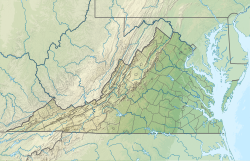| Scotts Mill Dam | |
|---|---|
| Location | Lynchburg, Virginia, U.S. |
| Coordinates | 37°25′27.26″N79°8′29.90″W / 37.4242389°N 79.1416389°W |
| Purpose | Water supply |
| Status | In use |
| Opening date | 1839 |
| Owner(s) | Luminaire Technologies |
| Operator(s) | Luminaire Technologies |
| Dam and spillways | |
| Type of dam | gravity and arch |
| Impounds | James River |
| Height | 20.5 ft (6.2 m) |
| Length | 925 ft (282 m) |
The Scotts Mill Dam, also known as the Lynchburg Dam or Scots Mill Dam, is a dam across the James River at the south end of Daniel Island in the city of Lynchburg, Virginia. The project includes a gravity dam spanning the left side of river and a small arch dam portion towards the right bank. The facility is used for water supply, there is no hydroelectric production. [1] The dam is located adjacent to the Griffin Pipe Products mill at this location. The facility once included a canal or lock structure, ruins are still visible on the right bank, for hydropower or river boat transportation; this feature is no longer in use.
